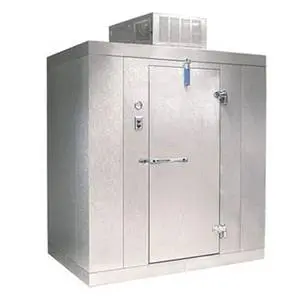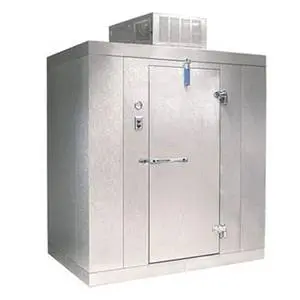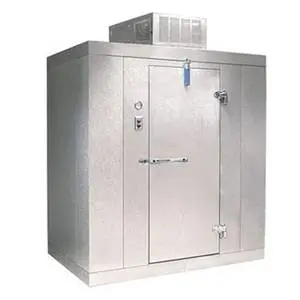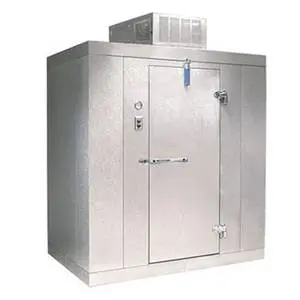Kitchen Applications: Walk-in refrigerators and freezers are primarily used to cool or freeze raw and cooked foodstuffs for daily production and inventory preservation.
Types: Walk-in refrigerators and freezers are manufactured in standard sizes, but can be customized or built into kitchens and supermarkets. They may be placed inside or outside a building, built with or without floors and may contain in-place or remote condensers.
Standard Features: Quality door designs are vital to the effective use of walk-ins, as doors receive the maximum stress during use. Rigid, reinforced doorframes and heavy-duty hinges provide maximum durability. Swing-out doors 24” to 34” wide are available with either left or right hinges. Deadbolt locking handles are standard on many models. Inside door releases are a standard safety feature that operators can specify as a push-bar for hands-free operation.
Walk-ins are available with self-contained refrigeration systems where the evaporator coil and compressor/condenser are mounted together on a frame, interconnected with pre-charged refrigeration lines and mounted on a ceiling or sidewall.
Unique Features/Technology: An air circulation system that allows a walk-in to draw in cold outside air when the exterior temperature is colder than the interior box temperature is available to supplement a unit’s compressor. Another option is a pressure relief valve designed to eliminate the slight vacuum created when warmer air enters a walk-in and expands when the door is closed, which can make it difficult for staff to open a unit.
Footprint: Prefabricated walk-ins start around 5' x 6'. Outdoor cold storage boxes can be constructed to fit any foodservice operation’s storage space needs.
Capacity: Allow 1 cubic foot of open storage area to accommodate 28 lbs of solid food product.
Energy Source: Small walk-in coolers commonly include a 1/2 hp compressor to maintain 35°F. Walk-in freezers have a 1-hp compressor to maintain a -10°F box temperature. Single-phase 115 volts can power small models, but most units require single-phase 208/230 volts.
Temperature Range: Coolers are typically set to maintain an interior temperature of 35°F and freezers -10°F. Units do have individual temperature controls.
Construction: Most walk-in boxes are made using prefabricated panels with urethane insulation sandwiched between aluminum or stainless steel. All manufacturers rate insulation with an “R-value”- most panels are rated around R-30, which requires about 4' of insulation. Panels are mass-produced in standard widths of 1', 2' and 4', and heights of 7 1/2', 8 1/2' and 9 1/2'.
Maintenance: Walk-in cold storage systems require proper airflow and ventilated areas and routine cleaning of condenser coils by a certified technician. A stainless steel outer construction is the most durable and easiest to maintain. Aluminum is cheaper, but dents easily and is more difficult to clean. Compressor/condenser units should be easily accessible, and multiple remote units should be grouped together to ease maintenance and servicing.
Manufacturers: ACityDiscount can supply a prefabricated walk-in refrigerator or freezer by Nor-Lake or Master-Bilt to suit your cold storage requirements. We can also customize a walk-in to suit your foodservice business' needs.
Federal Law for Energy Efficient Walk-Ins: Foodservice operators in California, Connecticut, Maryland, Oregon and Rhode Island with walk-ins are subject to energy efficiency standards. From January 1, 2009 all new walk-in refrigerators and freezers with a floor area of less than 3,000-square-feet installed in the U.S.A. will have to meet the requirements of an efficiency standard signed into law in December 2007. According to an analysis conducted for PG&E these standards will cut energy consumption up to 55%. Click here to read the actual requirements on page 73 (Title III Sec. 312). Master-Bilt and Nor-Lake have notified ACityDiscount they are currently manufacturing Walk-In Coolers and Freezers that meet the requirements.
Benefits of Walk-in Coolers and Freezers

Walk In Freezer 8 x 8 Outdoor 7'7ft H w/ floor
Nor-Lake
KODF7788-C
SKU# 43430
18,321.50$18,321.50
Login for more information
Free Shipping


Walk In Freezer 6 x 10 Indoor 6'7ft H w/ floor
Nor-Lake
KLF610-C
SKU# 43457
15,377.00$15,377.00
Login for more information
Free Shipping


Walk In Cooler 8 x 8 Indoor 7'7ft H w/ Floor & Refrigeration
Nor-Lake
KLB7788-C
SKU# 43392
14,669.00$14,669.00
Login for more information

Outdoor Walk In Cooler 6' x 10' x 7'7" Floor & Refrigeration
Nor-Lake
KODB77610-C
SKU# 43423
15,482.00$15,482.00
Login for more information

